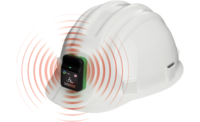"But the methods didn't work 100% of the time," says Hijazi. Tests showed that not all the workers' passive tags were read if they entered the gate simultaneously. Hijazi says the signal was blocked by their bodies, dropping the reading far below the 98% to 99% accuracy required.
Jochen Teizer, associate professor at the School of Civil and Environmental Engineering at the Georgia Institute of Technology, says the bus also got in the way. "The bus would act as a Faraday cage, blocking the signal from activating passive tags most of the time," he says. "Active tags, however, emit a signal constantly, and that might get through the windows of the bus." Hijazi's tests confirmed this, and active tags were selected for the job. However, the cost averaged $35 a tag, not including the cost of the readers.
CCC installed solar-powered active RFID readers with a range of 60 feet at all gates, with a 10-ft buffer zone between the readers' signal range.
"Vendors tell you active RFID tags last four years, but we found they last around a year at our use level," says Hijazi, who used battery-powered active tags.
CCC also tweaked the software's algorithms. Originally, if a worker took more than eight seconds to get in and out of the range of a reader, it would do a double read, thinking he had gone in and out.
Aaron Costin, a Ph.D. student at Georgia Tech, explains the problem. "The reader can send a signal often, but the algorithms need to change to recognize only the first read and ignore the rest," he says.
"Even during test phases, before the system was 100% installed, workers showed up on time," says Hijazi. "As soon as we announced the system, their behavior changed." They assumed they were being watched and tracked, he says.
Hijazi claims the $26,000 system was recouped in worker productivity over just a few months. If 500 employees save five minutes a day when working 26 days a month at a $6-per-hour average wage—or 50¢ for every five minutes—then the system saves the company $6,500 a month. The savings would only increase with higher wages.
But the benefits of worker tracking go well beyond ROI, says Reg Hunter, senior program manager at Fiatech, an industry consortium dedicated to testing and deploying new technologies to improve construction. "We have proven that RFID saves money," he says. "But site managers see the cash as an outflow only." Real-time knowledge of the workforce is the priceless part of monitoring a jobsite. "Being aware of what's happening on-site allows managers to pro-actively avoid problems by having the tools to make real-time decisions," Hunter says.
Looking Ahead
"As-built data acquisition and project monitoring in real time is the future. It is what BIM is lacking," says Teizer. He says BIM is only for design and planning but can be used during construction to track progress.
Teizer is testing real-time worker and equipment tracking with active RFIDs on an outdoor Shaw Industries refurbishment of a coal powerplant.
"We were trying to identify safety breaches," he says. Researchers tagged equipment, crane hooks and workers, then monitored movement patterns to see if workers and equipment crossed paths.
"It's the ultimate goal to know where workers are and give them instant feedback," adds Teizer. He works with Matt Reynolds, assistant professor for electrical and computer engineering at Duke University, on SmartHat, a hardhat equipped with a custom passive RFID tag. When a worker is too close to equipment, the low-powered tag emits a beep by harvesting energy transmitted from equipment-mounted RFID readers' radio waves. "It will take a lot of field trials and careful study, but we're optimistic," says Reynolds.









Post a comment to this article
Report Abusive Comment